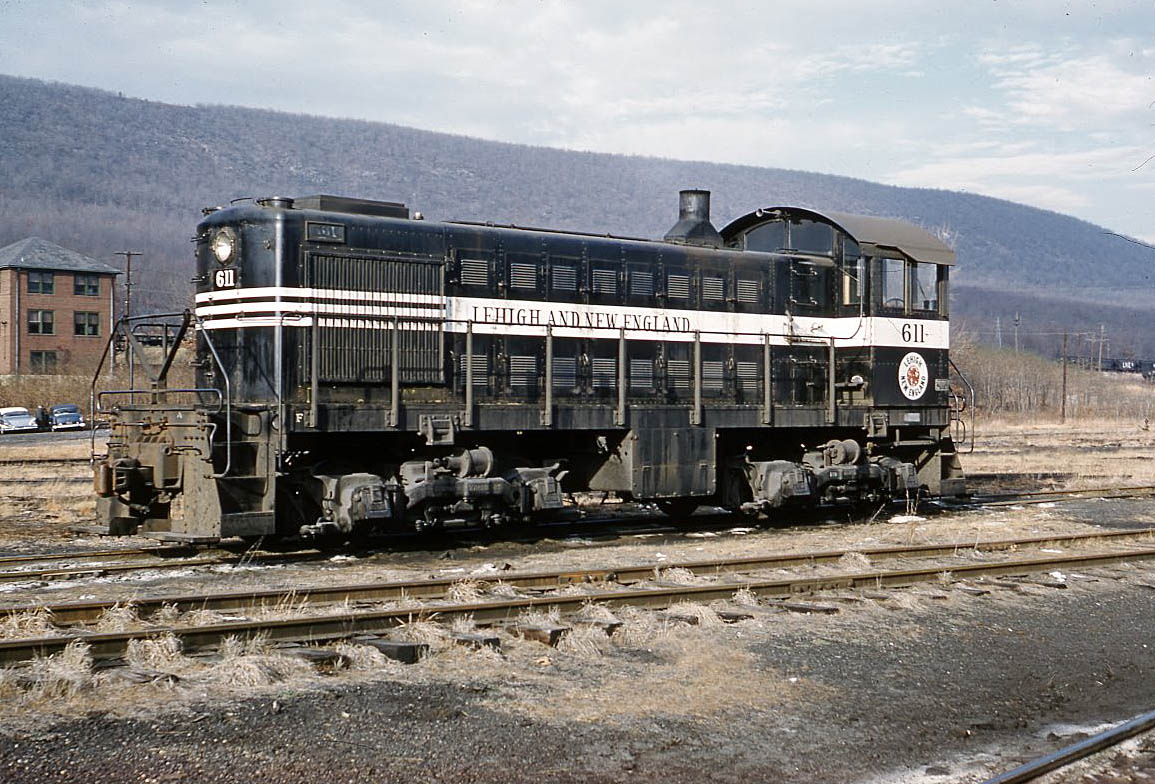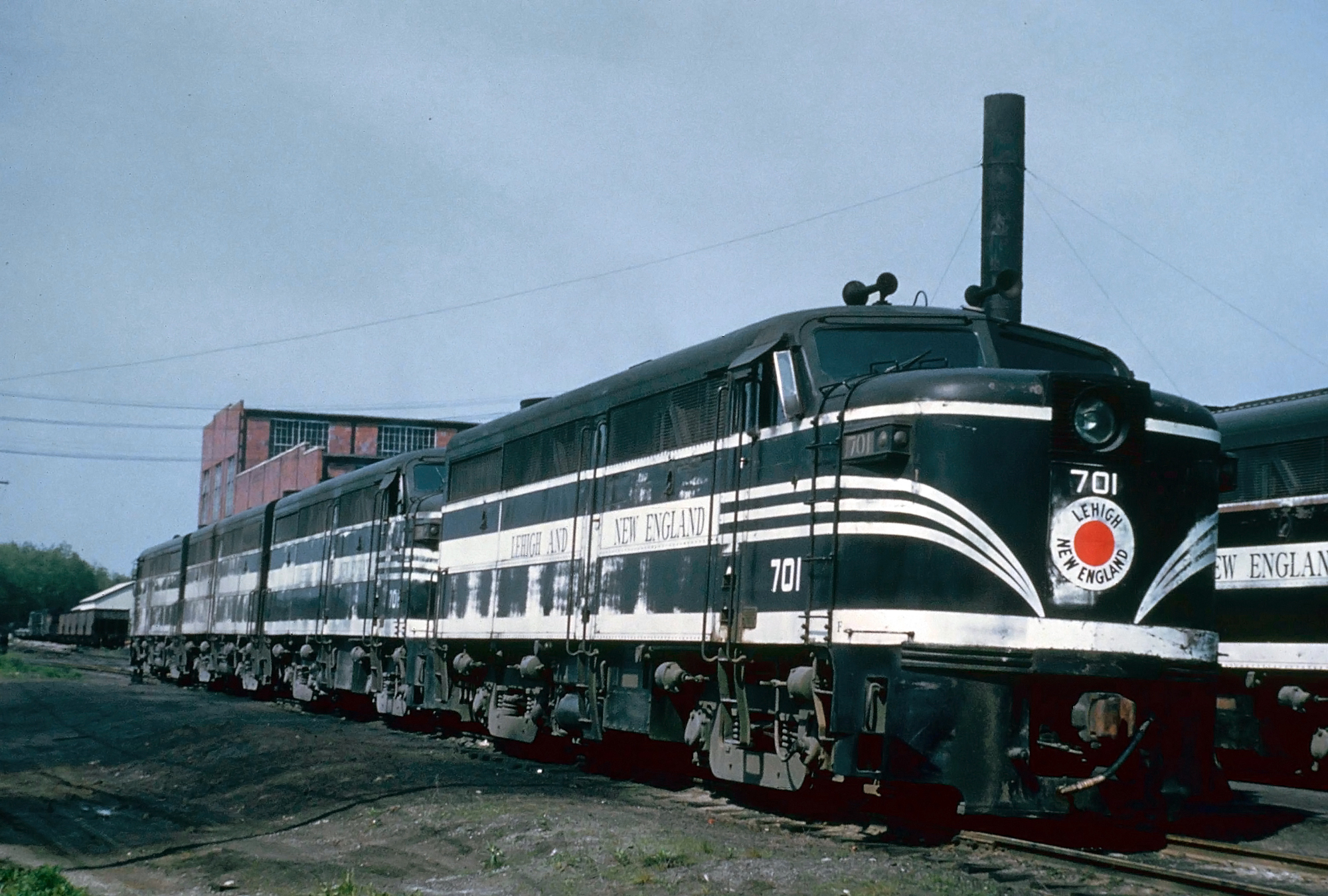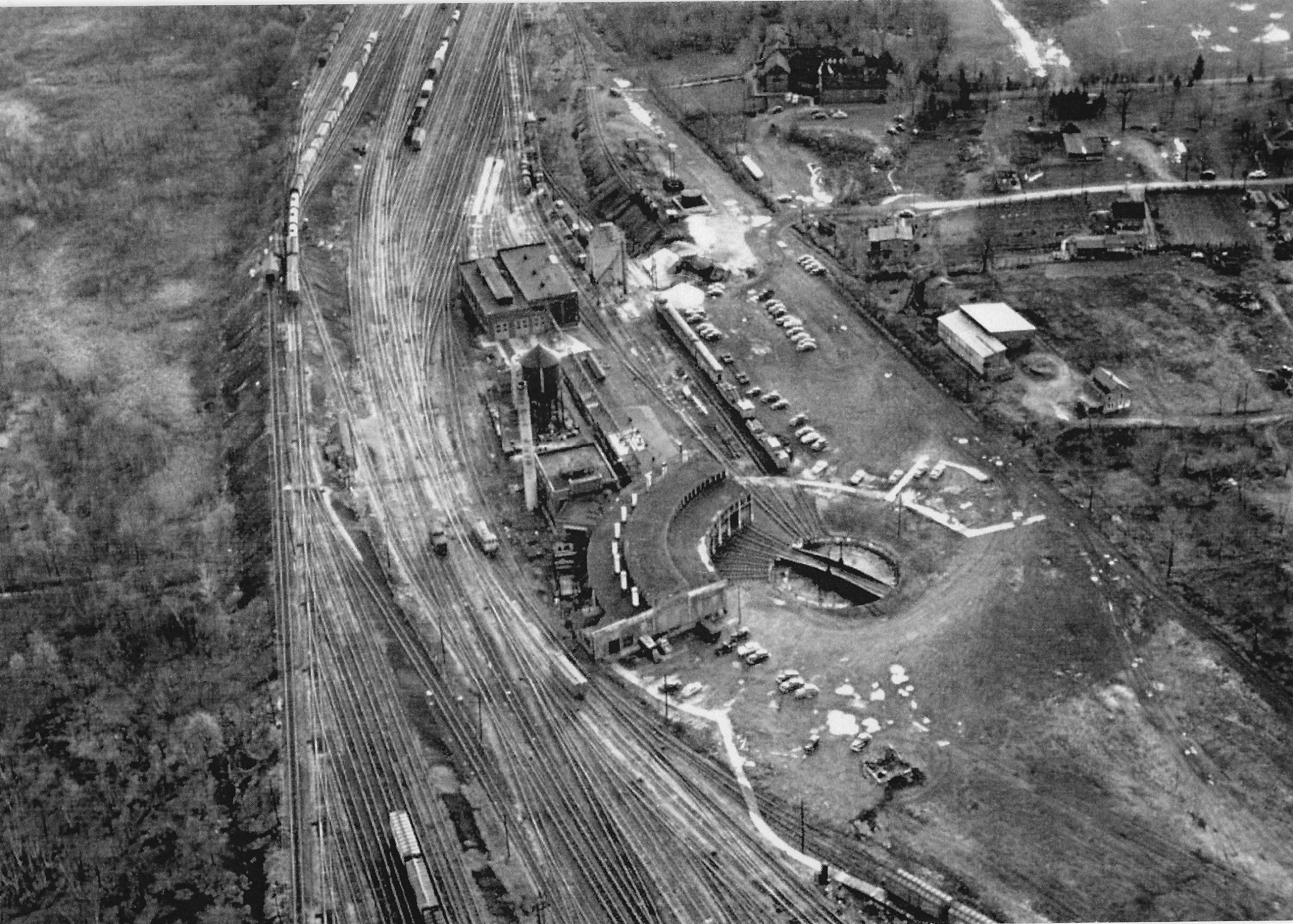
In reply to Pete Gossett (Forum Supporter) :
Cross-compound air pumps for the air brakes. Most railroads liked to tuck them under the running boards, others like Southern or Texas & Pacific liked to mount them on the pilot decks with sheetmetal covers, and then some, particularly C&O and Great Northern, preferred the "flying" air pumps. A lot of articulated engines hung them out front because if you slung them under the running boards, they'd be fighting with the steam pipes for the rear engine or crash into the front drivers as the front engine articulated. Mounting them out front was a real hassle though because you ended up with a tiny smokebox access hatch for cleaning out the smokebox, and if you needed to open the smokebox front to reflue it or anything you had to remove the pumps and all the plumbing.
C&O's F-19 Heavy Pacifics and K-3 Mikes were fearsome-looking machines, with Elesco feedwater heaters up top, a bell underneath, two cross-compound air pumps and a low-mounted headlamp


Following on from your Garratt posting. New Zealand Railways bought 3 of them in 1928. A 4-6-2- 2-6-4 and weighing 146 tons with 51,000 lbs of tractive effort they were the biggest steam engines built for NZ. Unfortunately they had all manner of issues, not least pulling the drawgear out of wagons but worst of all they were three complicated orphans. Withdrawn after only 2 or 3 years the running gear was re used under new boilers and frame to make 6 ordinary Pacifics which sadly had an equally undistinguished life although they did last 20 or so years. The boilers survived until 1966 supplying steam to the Woburn railway workshops.
They were undeniably powerful - it wasn't until the introduction of the 1425hp Da class diesels, a 3 ft 6 in gauge version of the EMD G12, in 1955 that a single loco could haul more tonnage up the Raurimu Spiral.

But wait there's more ...
another oddball engine type that was tried was the Fairlie. This design had a rigid frame with the engine(s) bogie mounted underneath. There were two variants - single and double referring to the number of power units. I have included a picture of the 'B' class double 0-4-4-0T. Two were purchased but didn't remain in service for long. 3 of the four power bogies went under steam cranes and I believe at least one still survives. The Denver and Rio Grande purchased an 0-4-4-0 in 1872, the only one in the US, The Mason Machine Works in Taunton Mass made at least one double Fairlie an 0-6-6-0.

NZ also had a number of single Fairlies, the 'R' class 0-6-4T (18 built in 1878 ) were later joined by the similar but more powerful 'S' class pictured here. Observant readers will notice the similarity to the Mason Bogies of a few posts back - William Mason was the US licensee of the patents.

RichardNZ said:But wait there's more ...
another oddball engine type that was tried was the Fairlie. This design had a rigid frame with the engine(s) bogie mounted underneath. There were two variants - single and double referring to the number of power units. I have included a picture of the 'B' class double 0-4-4-0T. Two were purchased but didn't remain in service for long. 3 of the four power bogies went under steam cranes and I believe at least one still survives. The Denver and Rio Grande purchased an 0-4-4-0 in 1872, the only one in the US, The Mason Machine Works in Taunton Mass made at least one double Fairlie an 0-6-6-0.
NZ also had a number of single Fairlies, the 'R' class 0-6-4T (18 built in 1878 ) were later joined by the similar but more powerful 'S' class pictured here. Observant readers will notice the similarity to the Mason Bogies of a few posts back - William Mason was the US licensee of the patents.
The Mason Bogie was an attempt to simplify a Fairlie but while it was simpler in some regards, it kept some and even added other complexities to the design that prevented widespread use.
RichardNZ said:Following on from your Garratt posting. New Zealand Railways bought 3 of them in 1928. A 4-6-2- 2-6-4 and weighing 146 tons with 51,000 lbs of tractive effort they were the biggest steam engines built for NZ. Unfortunately they had all manner of issues, not least pulling the drawgear out of wagons but worst of all they were three complicated orphans.
That's always been an issue when developing big power. When Erie and Virginian built those ridiculous 2-8-8-8-2 and 2-8-8-8-4 Triplexes, one of the (many) issues they had was that a train long enough to take advantage of the massive pulling power offered then exceeded the limits of the drawbars and so they ripped couplers apart and pulled draft gear out of cars. If Alco had built their 2-6-6-2+2-6-6-2 "Super Garrats", which were supposed to generate greater than 200,000lbs of tractive effort, they would have likely had the same issue. The PRR also tried running the world's largest train from Whiskey Island to Mingoes Junction on September 21st, 1967. They had 341 cars, 35,805 tons and 25,000 horsepower and they reached their destination but the rolling terrain and sheer length and weight of the train cost them 13 broken couplers during the trip due to severe slack action.
In addition to preventing string-lining, distributed power units (the unmanned locomotives cut into the middle of trains) help reduce coupler and drawbar strain because they essentially break the train down into multiple small trains traveling together, rather than one huge train.
In reply to LS_BC8 :
The 1949 C&O H-6s and the N de M HR-4s were very similar in appearance and engine wheelbase, their driver diameters were only an inch apart, and both used Walschaerts valve gear, but they were very different in all other regards.
The 1949 C&O H-6s (#1300-#1309) were oddities when delivered. Despite being the last locomotives built by Baldwin for a US common carrier, they were essentially reprints of the original C&O H-6s from 1920, which were an Alco product. Those 1920 Alco H-6s were also pretty much unchanged from the H-4s of 1912 and H-2s of 1911, both also Alco product. So, Baldwin's steam swan song was not a modern tour de force, nor was it even their own design. They were a compound engine, built at a time when, ignoring N&W's homebuilt Y-series 2-8-8-2s, the compound engine had long falled out of favor for single expansion engines. It was not equipped with a cast-steel engine bed, instead using the old fabricated frame method and it had traditional solid/friction bearings (despite what Wikipedia, Steamlocomotive.com and even Western Maryland Scenic Railroad's own website say). The only real modern touch the 1949 H-6s had were overfire jets, which were an appliance of dubious effectiveness. Baldwin also lengthened the combustion chamber a full foot, and shortened the flues a corresponding amount, and bumped the trailing truck diameter down 1". The 1949 H-6s also used conventional rectangular tenders versus the Vanderbilt cylindrical tenders that the earlier Alco H-6s used. All in all, the H-6s were a relatively compact, no-frills engine designed for dragging coal up out of West Virginia valleys at low speed
The H-6s had a 48.83 foot long engine wheel base, and an overall wheelbase of 88.56 feet. Engine weight was 434,900 pounds. The tender had a 12,000 gallon water capacity and a 16-ton coal capacity. They had 56" driving wheels. Boiler pressure was 210psi. The front low-pressure cylinders were 35"x32", while the rear high-pressure cylinders were 22"x32". They had a 389 square foot firebox with 72.20 square feet of grate surface, tube and flue lengths of 23', and 241 tubes of 2.25" diameter plus 36 flues of 5.5" diameter. The H-6s generated 70,773lbs of tractive effort and had a factor of adhesion of 5.18, which is sure-footed but pretty inefficient (the engine is carrying more weight than it needs for the power). They required a 115lb/yd rail to safely operate on.

The Ferrocarrill Nacionales de Mexico HR-4 2-6-6-2s were built in 1937 by Alco and were also unusual in that they were built as a simple/single-expansion design. The compound articulated had mostly fallen out of favor by then, so its not strange that they were single-expansion, but few simple 2-6-6-2s were built because that wheel arrangement had largely been supplanted by the 4-6-6-4 and, to a lesser extent, 2-6-6-4 arrangements by that point. Some of the details on these engine are hard to find with the only real description I see being "these standard-gauge freight engines were modern in every respect." Does that mean a cast engine bed or roller bearings? Hard to say, but those were pretty standard by 1937. One immediate glaring difference between the HR-4s and C&O's 2-6-6-2s was that the N de M engines were oil burners, while C&O's engines were coal-fired, befitting a railroad that largely made its money hauling black gold The HR-4s were also used differently, they were mainline freight engines. And the HR-4s were considerably longer lived, lasting until 1963, and thus being the last articulated locomotives in general revenue in North America.
The engine wheelbase was slightly longer at 49.58 feet. I can't find an overall wheelbase for them. The engine weight was considerably lighter at 400,960lbs. Tender capacity is also a question mark. Driving wheels were an inch taller, at 57". Boiler pressure was 40psi higher, at 250psi. As a single-expansion engine, all four cylinders were the same size, at 18"x30". They had a larger 423 square foot firebox but slightly less grate area at 70.30 square. Tube and flue lengths were shorter, at 20', and the boiler had 164 tubes of 2.25" diameter plus 40 flues of 5.5" diameter. They generated more tractive effort, 72,474 pounds, and due to the lighter weight and more power, they had a much more efficient factor of adhesion of 4.45. They were also capable running on 95lb/yd rails.

According to the folks at Western Maryland Scenic Railroad, the #1309 should be hauling trains by mid-December. Although, WMSR has been overly optimistic about their timelines once or twice before.
I've also heard that, after running its last trips on October 3rd, N&W #611 has not headed south to NC Transportation Museum and will be spending the winter at Strasburg. It doesn't sound like they have an winter operation plans, instead they are performing the required FRA inspection of the boiler’s flexible staybolts and caps. Future plans “will be published through official channels when appropriate." So, it's not established whether it will be hanging around and running at Strasburg next year or heading back to Spencer, NC.
There have been some people hoping that N&W #611 will make the short hop over to the Reading & Northern and maybe run some excursions over there on. I know to never say never, but I wouldn't count on it happening. I'm not sure that #611 could navigate a lot of the R&N system to begin with. That's some very curvy trackage and the N&W Js have a very stiff lead truck, a centering trailing truck and minimal lateral motion in the drive wheels. This was done to limit the dynamic imbalance or hunting or nosing motion that resulted at high speed due to their relatively short 70" drivers. It means that #611 and her ilk had very hard times on passing sidings and sharp curves, being prone to derailment, as well as accelerated wear of the lead truck wheel flanges. The N&W actually never trued J lead trucks on a lathe and reinstalled them. The wheelsets were replaced with new, and then taken and trued and installed on lesser power, like 4-8-0s and 4-8-2s.
Another factor is that Andy Mueller doesn't really seem that interested in hosting other steam locomotives. NKP #765 did travel through Jim Thorpe back in 2015, but it was running a Norfolk Southern excursion on the now-dead 21st Century Steam program. Other than that, and the trips with CNJ #113 out of Minersville, I don't believe that R&N has ever hosted any steam locomotives. Which makes a certain kind of sense, he wants to keep the spotlight on his own equipment.
Also, I've heard that NS grants #611 just one roundtrip ferry move a year. So, if they moved it over to Reading, or Temple, or Jim Thorpe, then it wouldn't be able to get back to Spencer. Not sure how true that is though.
I did see an amusingly clickbaity article titled "Locomotive #611 changes hands, will remain in PA." The #611 was not the famed N&W steam locomotive though, but an Alco S2 formerly of the Lehigh & New England, now the last intact L&NE diesel in existence. The Railroad & Industrial Preservation Society, Inc has purchased the S2 from the Lehigh New England Preservation Society and the Lehigh Valley Chapter of the National Railway Historical Society and plans to return the Alco switcher to operation at the Allentown & Auburn Railroad.

Yesterday actually marked the 60th anniversary of the Lehigh & New England's abandonment. Arguably the least-known of the Anthracite Roads, it was the second to cash in it's chips, after the New York, Ontario & Western.

Like most of the anthracite lines, it's roster was dominated by Camelbacks and immense, plodding 2-8-0s.

In the diesel era, the L&NE was primarily an Alco road, with a roster of S2s, RS-2s and FA cab units. All were trimmed in a handsome black with white stripes and red dot on the nose, although by the time this photo was taken, they were showing the road's poor health.

L&NE was one of the six "Maybrook lines" which utilized the New Haven's massive yard complex at Maybrook, NY. The rail line through Maybrook was originally constructed by the Hudson River Connecting Railroad in 1889, then acquired and turned into a rail yard by the Central New England Railroad. Minimal traffic on the CNERR meant it never had more than a small yard and a 5-stall roundhouse. In 1904, the New Haven saw potential in the line, since it would allow them to get their heavy freight across the Hudson easier than the current situation of using barges in New York City. Instead, they could just cross the Poughkeepsie Bridge and hand it over to other railroads to head west. By 1912, the yard had grown to 3 miles in length with six separate yards, including two hump yards, and a refrigerator car icing facility. They built a 10-stall roundhouse, which later grew to 25 stalls with a 95-foot turntable.
With six major railroads serving the yard, Maybrook eventually grew as large as 71 miles of total track lengths over 177 tracks.


But things began to fall apart in the early '50s. First, four of the railroads serving Maybrook had their fortunes tied directly to anthracite, the O&W, the L&HR, the L&NE and the Erie. Anthracite fell out of favor for home heating and mines began to play out, and those four railroads began to suffer. By the mid '50s, Maybrook was down to 99 tracks with about 50 miles of track length. Then, in 1957 the NYO&W called it quits and filed for abandonment. In 1960, the two hump yards were leveled and converted to flat switching. In 1961, the Lehigh & New England also filed for abandonment, leaving just the New Haven, the New York Central, the Erie-Lackawanna and the Lehigh & Hudson River. Yard traffic fell to what it was before New Haven acquired it in 1904. In 1969, the New Haven was incorporated into the Penn Central merger, which really hastened Maybrook's downfall. Interchange with the Erie-Lackawanna was discouraged, since the Penn Central could instead run New Haven freight traffic west over the NYC/PRR routes, rather than hand it off to the E-L. After 1971, only one E-L train stopped in Maybrook each way, and that was only to change crews, not interchange with Penn Central or Lehigh & Hudson River. Traffic through the yard finally ended in 1974, when the Poughkeepsie Bridge burned and severed the Lehigh & Hudson River's connection with New England and ultimately killed off the L&HR. Penn Central was of course, in no shape to rebuild the Poughkeepsie Bridge, and even if they were, they no longer needed the bridge since they had access to New England via the New York Central's old Boston & Albany subsidiary line. Even before Poughkeepsie Bridge burned, they had already diverted most of their traffic through Selkirk instead.

Maybrook got a brief revival in the 1980s, when the New York, Susquehann & Western began running trains into Maybrook on the L&HR line from Sparta Junction to Maybrook, then reversing the train at Maybrook Yard and running back out the same end on the Erie connection back to Campbell Hall, where it got on the old Erie main line. Later, a direct connection from the ex-Erie main line to the ex-L&HR would later obviate this reverse move.

Today, Maybrook Yard is entirely gone, although the abandoned New Haven yard office still stands.

You'll need to log in to post.